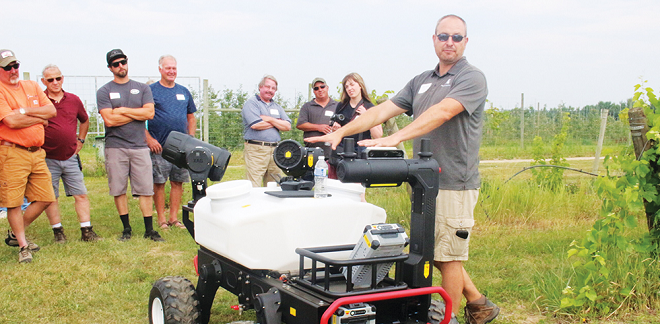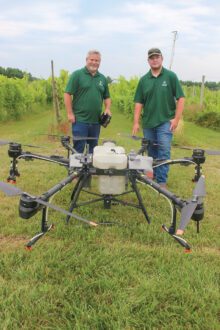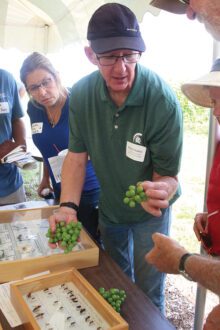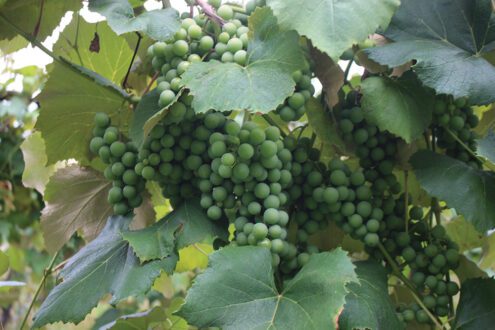
Sep 15, 2023MSU researches drones to control vineyard pests
At the annual Viticulture Field Day in late July at Michigan State University’s (MSU) Southwest Michigan Research and Extension Center in Benton Harbor, winegrape growers assessed autonomous tools for tasks including pest management.
“One of the options we can go to is some more autonomous, targeted technologies,” said Mike Reinke, MSU viticulture specialist. “We started to do some work in these drones the last couple of years. We’re at the stage where we’re starting to shift gears a little bit and go from demonstrations to actual efficacy trials.”


Reinke has partnered with Kirk Babcock, owner and licensed pilot with Battle Creek-based Aerial Ag Technologies.
For those interested in flying their own or talking about the details on what it takes to operate their own agricultural sprayer, Reinke has been conducting much research, Reinke said.
“You guys understand how changing the nozzle on your airblast (sprayer) will change how the coverage looks,” Reinke said. “It’s the same thing with these drones.”
Kirk Babcock and his son, Jacob, demonstrated an autonomous Rantizo DJI T30 spray drone.
“We had a lot of questions about if this is actually coming into the industry and getting used a lot, how good is it? How well does it work?” Kirk Babcock said.
They won’t replace an on-the-ground airblast sprayer, he said.
“These drones are actually just another tool that you all have as growers in case you need something,” Kirk Babcock said. “We all know the timeliness of the application is important. If you can’t get your ground sprayer in or through something, or everything’s wet, this gives you another tool to get something in there to get the job done.”
Map before you spray
Aerial Ag uses a smaller drone to scan and produce a precise 3D map of the vineyard, which is downloaded to the spray drone.


discusses late-season grape insect pest management at the field day.
“We need to map the field because when we’re dealing with vineyards, we’re dealing with three dimensions,” Babcock said. “It isn’t like row crops where we’re basically a two-dimensional field and the general height above it, and we’re good to go. We’re dealing with an extra dimension that’s very important.”
Once the map is set, the drone knows where to go, regardless of the terrain.
“Three dimensions is very important when we need to stay five feet or something above the canopy, or whatever height we determine is the best for what we are doing,” he said. “It will stay exactly, no matter whether the hills are rolling, or what. It will stay right above that. I’m mapping the field to tell it where to go, but for the most part it’s doing everything on its own.”
Sprays: how much is enough?
Drones have the ability to apply the same rate of materials continuously throughout the vineyard. Reinke said his research focuses on applying about five gallons of insecticide per acre.
“You’ll hear a lot of drone manufacturers, and some pilots, recommending less amounts, like two gallons, but we’re just not seeing the droplets that are necessary,” Reinke said. “We’re going to be looking at more research with more gallonage, maybe seven to 10. With five gallons we’re getting good minimal coverage, so we’re pretty confident you can get some good, effective sprays.”
Reinke said the drone program is targeting grape berry moths. The research involves looking at coverage within the canopy — where the difference between using five gallons per acre versus two gallons becomes evident.
The lesser amount treats the top of the canopy, but the product doesn’t penetrate it.

Other aerial sprayers, such as helicopters or planes, cover an area much faster, but drones hover and allow for better precision and penetration.
“Think of it more like an airblast sprayer turned on its head,” Reinke said. “It’s shooting air straight down. It’s controlling those droplets. If you can imagine that air coming down between the rows, that air has to go somewhere. It’s captured by the vines.”
Babcock said Aerial Ag charges for the service by the hour based on the crop type and chemical usage. Growers interested in obtaining a drone sprayer and doing the applications themselves face some stiff regulations.
“We talk about UAVs (unmanned aerial vehicles) being a new, interesting technology, but there’s some legal issues involved in flying something,” Reinke said. “We really like working with custom applicators because they have all the permits, they’ve gone through all the education. They understand these aircraft.”
— Gray Pullano, senior FGN correspondent
Top photo: Autonomous UGV Sprayer as an option for growers during the Viticulture Field Day.














